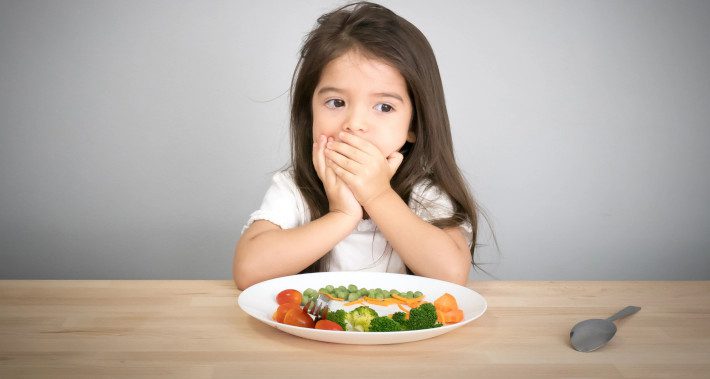
“My child will only eat junk food”
“My child refuses to eat vegetables”
“My child gags at the sight of mushy food”
“My child will not eat at school”
“My child pushes away any food I offer them”
If any of these statements remind you of your child, you may have a “picky eater” at your table.
And you are certainly not alone: according to the Canadian Paediatric Society, 25-35% of parents in Canada report their toddler or preschooler as a “picky eater”(2012).
When a child lacks a variety in their food preferences, eats less than 30 foods, or stops eating previously enjoyed foods, they may be considered a picky eater.
While it can be puzzling to understand why eating certain foods can bring on such distress for some children (e.g., crying, screaming, leaving the table), we should consider the many demands placed on a child while eating. Eating is a highly sensory and physical task.
For example, there are many smells experienced while eating, food changes in size and texture as we eat it, some foods require more mature chewing skills than others, and utensils can be tricky to manipulate.
Thus, underlying a child’s picky eating is typically some level of challenge with oral motor skills (e.g., chewing, swallowing), sensory processing (e.g., over-responsiveness to textures, taste and smell) and/or expanding food preferences.
As stressful as it may be when your child is rejecting food during mealtimes, a gradual, play-based approach is often recommended to support your child in building his/her tolerance to new foods.
If you have a picky eater at your table, here are some tips to help your child feel more comfortable with trying new foods:
1. Avoid telling your child to “just try it”
This places pressure on the child and may contribute to a cycle of stress, discomfort, and food avoidance as it is likely that the foods they are refusing are beyond their current skill level or sensory tolerance.
To reduce mealtime struggles, start off by having a discussion with your child about the food – talk about its colour, shape, size, texture, etc. (For example, “These peas are bright green, just like your favourite jell-o, but they are little and round and they feel different” or “The carrots are orange like your goldfish. I wonder if they will be crunchy too?”)
2. Explore food in fun new ways!
Children learn best through play and sensory experiences.
Make shapes, using cookie cutters, with food like watermelon or sandwiches.
Build structures with food, like pretzels or green beans, as if they were the houses from the 3 Little Pigs .
Finger paint with food, such as yoghurt or pudding.
Or, find hidden treasure in a puree like applesauce.
Fun adventures seem to contradict the little voice in your head saying “Didn’t your mother ever tell you not to play with food?”, but for picky eaters, these positive experiences with food help them begin to tolerate the smells, textures, and sensory experiences that are required to confidently taste new foods.
We’re not saying play with your food ALL the time, but don’t be afraid to get messy in a “special snack time” or enjoy a picnic or two outside this summer!
3. Involve your children in shopping and food prep
Inspire your child to learn about food by inviting him/her into the kitchen to help you cook or bake.
Encourage them to be your “sous chef”, which will expose them to a variety of new sensory experiences.
For example, try making homemade pizza. Your child can help spread the sauce, sprinkle on the cheese, and place different ingredients on top.
When you go grocery shopping, involve your child in picking out the fruits and veggies and putting them into bags.
Ask your child to help you count the apples, or choose the yellowest spaghetti squash or best tree-look-alike (broccoli).
4. Reward your child for any attempt!
If your child is showing interest in a new food but is hesitant to take a bite, try a gradual approach by encouraging a small “snake lick” or “bunny bite” first and make sure to acknowledge them for their attempt (e.g., “That was such a terrific mouse nibble!”).
Maybe next time, they will try a “cow chew” and eventually, they might be willing to do a “shark bite” or “dinosaur chomp”!
5. Be a role model for your child during meal times
Your child will be more comfortable trying a new food when they see others at the table eating the same foods.
Put a variety of foods on your plate, try new food, talk about the food you are eating and demonstrate good manners.
Avoid speaking negatively about foods and if your child uses such language (e.g., “That’s gross” or “It’s yucky”), help them re-frame their thinking by modelling neutral statements, such as “That’s a new flavour!” or “That tastes different”.
We have lots more tips and ideas so if you have concerns about your child’s eating habits, feel free to contact us at Aurora Speech Clinic or check out the following resources:
https://www.choosemyplate.gov/preschoolers-picky-eating
www.momables.com (for fun and easy recipes to make this summer!)
Happy Munching,
Sarah de Almeida
Occupational Therapist
372 Hollandview Trail, #302,
Aurora, ON L4G 0A5
(905) 503-4321
» https://goo.gl/maps/fg3XKnNsczzwLzTz7
Aurora Speech Clinic is located in Aurora, ON and offers personalized skilled intervention to those struggling with their speech and language skills. Services offered include screening, consultation, and comprehensive evaluation. We also provide one-on-one and/or group therapy for speech sound disorders, receptive/expressive language delay/disorder, stuttering/cluttering, accent reduction, and much more.